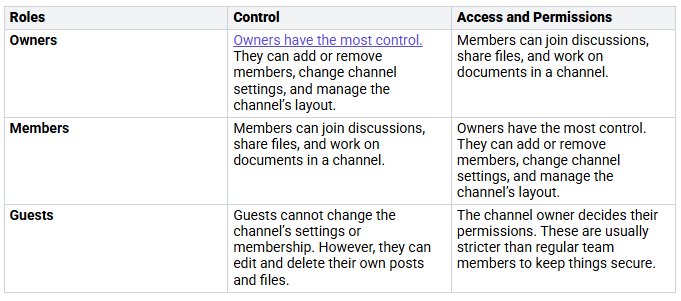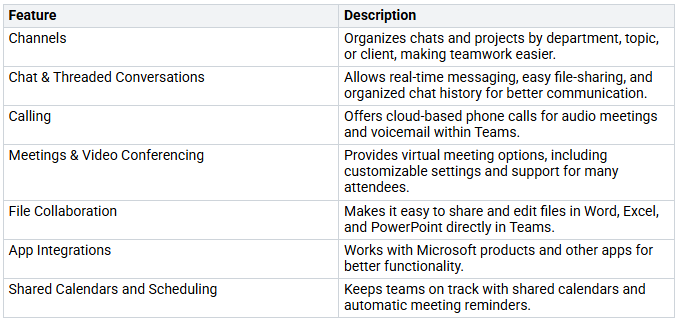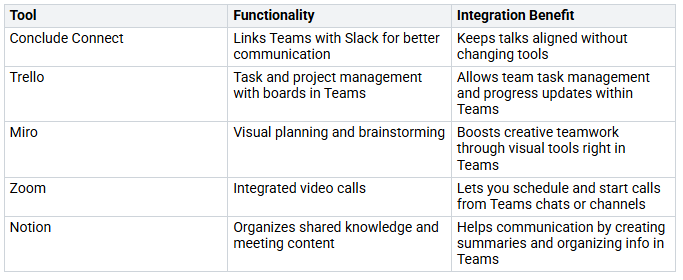Are you feeling stressed by the mess of Mastering Microsoft Teams? You’re not the only one! Many users face problems like too many teams, low participation, and too much information. This often happens because there is no clear control over how to use it. Without clear rules, team members may struggle to use the platform well. Also, not enough training can make you feel confused. Using the right strategies can change your experience and help you in mastering Microsoft Teams better.
Key Takeaways
Make clear rules for communication in your team. This helps everyone understand how to share news and reply well.
Create channels with specific purposes and clear names. This organization cuts down confusion and helps teamwork.
Make sure everyone knows their roles in the team. When people understand their tasks, trust and efficiency grow.
Use Microsoft Teams tools like channels, chat, and video calls. These help make communication and working together easier.
Support team involvement with recognition programs and regular check-ins. This builds a positive culture and keeps everyone linked.
Communication Norms
Setting clear communication norms in Microsoft Teams is very important. It helps create a good work environment. When you set these norms, you guide how your team talks to each other. This makes it easier for everyone to know where to share updates, how to reply, and which tools to use for different messages.
Defining Channels
Defining channels well can really improve your team’s work. Here are some tips to help you make useful channels:
Identify Team Needs: First, find out which teams and members will use each channel. This way, everyone finds the discussions helpful.
Use Descriptive Names: Give clear and descriptive names to your channels. This helps team members quickly see what each channel is for.
Establish Guidelines: Share the rules for using each channel. Make sure everyone knows what type of content goes where.
By organizing chats in channels, you improve teamwork and reduce confusion. Research shows that 75.7% of people said team communication is clear. Also, 92.5% agreed that clearer communication helps productivity. This shows how much well-defined channels can help your team’s success.
Setting Response Expectations
Setting clear response expectations is also very important for good communication. Here are some best practices to think about:
Keep Teams Open: Always keep your Teams app open for work. This keeps you connected and ready to respond.
Manage Your Status: Use your status to show if you are available. Change your ‘do not disturb’ settings to reduce interruptions.
Be Clear in Requests: When you ask something, be specific about what you need. This helps others reply correctly.
Use @Mentions Wisely: Use @mentions to get attention without being annoying. This makes sure the right people see your messages.
Understand Urgency: Treat urgent messages in Teams like emails. Expect replies within the day, but remember your colleagues have their own work.
Utilize Threads: Keep chats organized by using threads. This helps keep conversations clear.
Use Emoji Reactions: Instead of sending short follow-up messages, use emoji reactions to quickly acknowledge messages.
By following these tips, you build a culture of responsibility and respect in your team. Remember, good communication is not just about the tools; it’s about how you use them.
Managing Remote Teams
Managing remote teams can be tough. But with the right plans, you can make a strong and productive team. Microsoft Teams has many tools that help team members talk and work together, no matter where they are.
Clarifying Roles
One of the first things to do for good remote team management is to clarify roles. When everyone knows what they need to do, it cuts down on confusion and helps productivity. Here are some best practices for clarifying roles in your team:
When each member knows their role, it builds trust and responsibility. This clarity helps everyone focus on their work, leading to better results. Research shows that managers who see on-task focus as a benefit of remote work think their teams work better. This means that when roles are clear, team members feel more effective in their jobs.
Utilizing Microsoft Teams Features
Microsoft Teams has many features that help remote teamwork. Here’s how you can use these tools to boost your team’s performance:
To make remote team management better, think about these strategies:
Cultivating a Collaborative Culture: Plan regular fun activities and use teamwork tools to build team connections.
Prioritizing Trust and Autonomy: Focus on results instead of hours worked and create clear processes.
Managing Productivity and Accountability: Set clear goals and check in regularly to keep productivity high.
Supporting Employee Well-Being: Encourage a balance between work and life and provide mental health support.
Embracing Diversity and Inclusion: Respect different cultures and give equal chances to all team members.
Investing in Technology and Training: Give teams the right tools and teach them how to use collaboration platforms.
Adapting Leadership Styles: Be friendly and show understanding to help team members.
Continuous Improvement and Feedback Loops: Ask for feedback and try new ideas to improve team efficiency.
By using these features and strategies, you can create a better remote team environment. Remember, the benefits of remote work can help managers be more effective. So, focus on building a positive culture and using technology to improve teamwork.
Effective Channel Management
Managing channels well is very important for reducing chaos in Microsoft Teams. When you organize your channels, you make communication easier and teamwork better. Here’s how to find the right number of channels and group them logically.
Balancing Channel Quantity
Finding the right number of channels can be hard. Too many channels can confuse your team. But too few can make things messy. Here are some tips to help you find that balance:
Establish Clear Purposes: Say what each channel is for. This helps everyone know where to share updates and talk.
Implement Notification Hygiene: Let team members change their notification settings. This way, they can focus on what is most important.
Utilize Mute and Hide Features: Encourage users to mute or hide channels that don’t matter to them. This cuts down on distractions.
Regularly Review Channels: Check for channels that are not used and archive them. Keeping the channel list updated helps everyone stay focused.
Encourage Structured Discussions: Support meaningful talks and stop the creation of extra channels.
By following these tips, you can make a more organized and efficient space in Microsoft Teams.
Grouping Channels Logically
Grouping channels logically makes them easier to use. Here are some strategies to think about:
Use More Than Just a ‘General’ Channel: Use the General channel for important announcements only.
Include a Help or Training Channel: This helps users who need help using the platform.
Maintain Consistent Naming Conventions: Use clear names for channels to create a smooth digital workplace.
Create Sections for Different Topics: Organize channels by themes or projects. This helps team members find the right discussions easily.
Here’s an example of good channel structures for different teams:
Good channel management organizes communication, centralizes tasks, and connects tools. This method makes workflows smoother and teamwork better. When you set up your channels wisely, you boost productivity and cut down on confusion.
Enhancing Team Collaboration
Making a teamwork-friendly space in Microsoft Teams can really help your team do better. When you support participation and use built-in tools, you create a place where everyone feels important and eager to help.
Encouraging Engagement
To boost engagement in your team, try these helpful ideas:
Implement Recognition Programs: Celebrate wins and lift spirits by recognizing what team members do. Use apps like TeamsSticker to show thanks and highlight successes.
Create Dedicated Channels: Make special channels for different topics and team activities. This keeps talks focused and on point.
Schedule Regular Check-Ins: Set aside time for regular chats. Frequent check-ins help keep friendships strong and make sure everyone is on the same page.
Integrate Service Desks: Bring support together to cut down on switching platforms. This makes communication smoother and helps productivity.
Utilize Feedback Tools: Use apps for recognition and feedback to build a positive work culture. This encourages open talks and ongoing improvement.
By using these ideas, you can build a place where teamwork flourishes. Remember, a teamwork-friendly culture improves communication, making workers feel appreciated and involved.
Utilizing Integrated Tools
Microsoft Teams has many built-in tools that help teamwork effectively. Here’s a look at some of the best tools:
These tools not only make workflows easier but also improve the overall teamwork experience in Microsoft Teams. By using these built-in features, you can keep your team connected and productive.
Building Trust and Accountability
Building trust in your teams is very important for a good work environment. Trust helps how teams work together. When team members trust each other, they talk openly and work well together. This trust creates a feeling of reliability, skill, and openness among team members.
Here’s how trust affects team dynamics:
o set clear roles, focus on talking openly about responsibilities and expectations. This helps everyone know their part and reduces confusion. Here are some good ways to set clear roles:
Talk openly about roles, responsibilities, expectations, and limits. This helps create better working relationships.
Set specific and measurable goals to help remote teams stay focused and build confidence in everyone’s work.
Make clear expectations to keep trust among team members.
Strengthening communication norms is also very important for building trust and accountability. When you set clear communication rules, you create a guide for how your teams interact. Here are some best practices to think about:
To promote accountability among team members, try these strategies:
Delegate tasks well: Know team members’ strengths and match tasks to them.
Set clear communication channels: Define rules for interactions to ensure smooth communication.
Track progress and results: Watch team performance and set clear goals.
Give regular feedback: Provide helpful feedback quickly to improve performance.
Use the right tools: Use technology to improve visibility and accountability in workflows.
By focusing on trust and accountability, you create a strong structure that boosts productivity and teamwork in your teams. Remember, a solid foundation of trust leads to better teamwork and improved results.
In conclusion, getting good at Microsoft Teams can change how your team works together and gets things done. By setting clear rules for talking and managing channels well, you make a better work space. Studies show that good communication in shared work areas helps people be more productive. Some companies have even saved between $8.8 million to $21.7 million. So, spend time using these best practices, and see your team succeed! 🌟
FAQ
What is the best way to start mastering Microsoft Teams?
To start mastering Microsoft Teams, get to know its features. Look at channels, chat tools, and file sharing. Set clear rules for communication and support team work. Practicing often will help you feel more at ease with the platform.
How can I improve remote team communication in Microsoft Teams?
You can improve remote team communication by clearly defining channels, setting response expectations, and using @mentions wisely. Regular check-ins and feedback also boost engagement and keep everyone connected.
What features should I focus on for effective remote management?
Focus on channels, chat, video calls, and file sharing features. Use tools like Planner and OneNote to make tasks easier. These features help you manage remote teams well and keep everyone on the same page.
How do I encourage team engagement in Microsoft Teams?
Encourage team engagement by celebrating achievements, making special channels for discussions, and planning regular check-ins. Use feedback tools to promote open talks and create a positive team culture.
What are common mistakes to avoid in Microsoft Teams?
Common mistakes include having too many or too few channels, unclear communication rules, and missing regular updates. Avoid these issues to keep a strong and productive environment in Microsoft Teams.


















